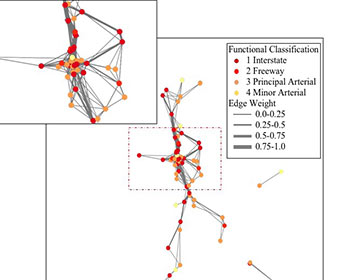

Research Reports |
| Title: | Big Transportation Data Analytics |
| Authors: | Xiaoyue "Cathy" Liu and Zhiyan Yi |
| University: | University of Utah |
| Publication Date: | Mar 2021 |
| Report #: | MPC-21-428 |
| Project #: | MPC-543 |
| TRID #: | 01769067 |
| Keywords: | data analysis, machine learning, mathematical prediction, spatial analysis, traffic data, traffic forecasting, traffic volume, vehicle trajectories |
| Type: | Research Report – MPC Publications |
 Traffic volume data are crucial in many applications, including transportation operation analysis, congestion management, and accident prevention. Yet an extensive capture of accurate volume information on a large-scale network can be difficult and costly. This research focuses on hourly traffic volume prediction in a statewide network using spatial-temporal features and heterogeneous data sources. We present a classic machine learning technique – support vector machine (SVM) – and compare its efficiency for traffic volume prediction with traditional estimation methods. Further, the study develops an innovative spatial prediction method. The method is built off a state-of-the-art tree ensemble model – extreme gradient boosting tree (XGBoost) – to handle the large-scale features and hourly traffic volume samples. Moreover, spatial dependency among road segments is considered using graph theory. Specifically, we build a traffic network graph using probe trajectory data, and implemented a graph-based approach – breadth first search (BFS) – to search neighboring sites in this graph for computing spatial dependency. The proposed spatial dependency feature is subsequently incorporated as a new feature fed into XGBoost. The proposed methods are applied to 101 continuous count station (CCS) sites in the State of Utah. Prediction accuracy and training time are compared across the proposed models.
Traffic volume data are crucial in many applications, including transportation operation analysis, congestion management, and accident prevention. Yet an extensive capture of accurate volume information on a large-scale network can be difficult and costly. This research focuses on hourly traffic volume prediction in a statewide network using spatial-temporal features and heterogeneous data sources. We present a classic machine learning technique – support vector machine (SVM) – and compare its efficiency for traffic volume prediction with traditional estimation methods. Further, the study develops an innovative spatial prediction method. The method is built off a state-of-the-art tree ensemble model – extreme gradient boosting tree (XGBoost) – to handle the large-scale features and hourly traffic volume samples. Moreover, spatial dependency among road segments is considered using graph theory. Specifically, we build a traffic network graph using probe trajectory data, and implemented a graph-based approach – breadth first search (BFS) – to search neighboring sites in this graph for computing spatial dependency. The proposed spatial dependency feature is subsequently incorporated as a new feature fed into XGBoost. The proposed methods are applied to 101 continuous count station (CCS) sites in the State of Utah. Prediction accuracy and training time are compared across the proposed models.
Liu, Xiaoyue "Cathy", and Zhiyan Yi. Big Transportation Data Analytics, MPC-21-428. North Dakota State University - Upper Great Plains Transportation Institute, Fargo: Mountain-Plains Consortium, 2021.